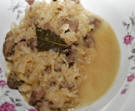| Polish Food :: POLISH CUISINE :: | ||||
| [ « go back ] | ||||
|
Bigos is one of the most representative dishes of Polish cuisine. It is made of sweet cabbage and sauerkraut (after a controlled fermentation process), several kinds of smoked and raw meats, and specially selected ingredients-dried plums, wild mushrooms, juniper berries, peppercorns, onion and sour apples. This concoction is then seasoned with honey and red wine. Fast food fans beware-bigos needs no fewer than three days to reach full flavor.
|
CUISINE OF POLAND Polish cuisine is not as famous throughout the world as for instance French, Italian, Chinese or Indian cooking but it certainly deserves acknowledgement for its original taste and appearance. Some traditions and recipes are an indigenous part of Polish culture. One example is "black soup," which was traditionally served by the parents of a young lady to an unwelcome suitor. This soup, also known as czernina, is prepared from duck or goose blood, giving it a dark hue. This somewhat horrifying delicacy takes you back in time to the world of Old Polish feasts, which often lasted for hours. Many courses were served, including roast deer, hare, pheasant and various other wild games. Such feasts came as a great surprise for foreign guests staying at the courts of Polish magnates and kings. Visitors from abroad often complained about too much seasoning, especially saffron and salt. For the Polish nobility in the 16th and 17th centuries, however, spices were a symbol of prosperity and refinement, as well as a way to experience new and foreign flavors. There are many restaurants in Poland offering excellent dishes from all over the world. Yet it is really worth discovering Poland's own national cuisine; indeed sampling the art of cooking as practiced in any country is always an important way of getting to know that nation's culture and tastes. Typical Polish starters are herring (in sour cream or olive oil), and fish or turkey in aspic. Next come the soups. There's quite a few to choose from: consomm with home-made noodles, barszcz (beetroot soup) with uszka (small ravioli), patties or kolduny, zur (prepared from soured rye flour) with hard boiled egg or white sausage, the wonderful chlodnik (served cold and made from soured milk, cream, young beet leaves, beets, radishes, cucumbers and finely chopped fresh dill), pea soup, wild mushroom soup, sorrel soup, tomato soup and many others. Moving on to the main course, pork dishes that deserve recommendation include breaded chops from pork fillet, shin of pork, bigos (recipe see below), golabki (white cabbage leaves stuffed with mince pork and rice), and various roasts and stews. A delicious Polish specialty is roast duck with apples. Other delicious not to be missed include the multitude of different kinds of pierogi (dumplings, stuffed with fresh cabbage or sauerkraut, sauerkraut and wild mushrooms, meat, or cottage cheese and bilberries), pyzy (potato dumplings served by themselves or stuffed with meat). Poland also boasts a rich selection of desserts. In terms of beverages, Poland produces an assortment of juices, mineral waters and beers (Tyskie, Zywiec, Okocim,Warka, Lezajsk). There are also Poland's meads, and the vodkas that have gained popularity worldwide, such as Zubrowka (bison grass vodka), Krupnik (made with honey and often mulled before serving), and the clear (white) Wyborowa and Zytnia. To these we should also add the many herbal and fruit liquors prepared on vodka base. BIGOS - The Polish Palate - try it yourself Serves 10-12 persons, preparation: 1
hour, cooking: 2-3 hours.
|
|||
|
|
||||
